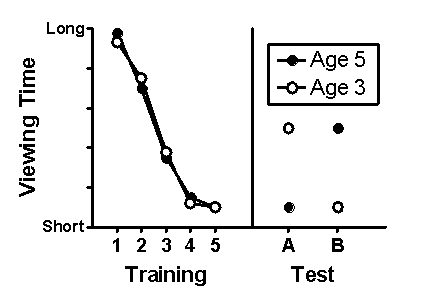Scenario I
Scenario I is based on and presents fabricated results consistent with the following study:
Kim, I. K., & Spelke, E. S. (1992) . Infants' sensitivity to effects of gravity on visual object motion. Journal of Experimental Psychology: Human Perception and Performance, 18(2) , 385-393.
Kim and Spelke (1992) investigated the extent to which infants have expectancies of gravitational effects on visual object motion. Three- and five-month-old infants repeatedly watched a video of a ball accelerating as it rolled down an incline until they spent little time actively looking at it. Subsequently, two types of test trials were conducted in randomized order. Type A test trials consisted of a ball slowing down as it rolled up an incline. Type B test trials consisted of a ball slowing down as it rolled down an incline. During all trials, the amount of time looking at each visual display was recorded. Fabricated data consistent with the major finding of this study are presented in Figure 11.1.
Figure 11.1 
-(Scenario I) Based on the data shown in Figure 11.1, which group(s) of infants, if any, appear to possess a concept of gravity?
Definitions:
Panic Disorder
Recurrent experiencing of attacks of extreme anxiety in the absence of external stimuli that usually elicit anxiety.
Post-Traumatic Stress Disorder
A mental health condition triggered by experiencing or witnessing a terrifying event, marked by flashbacks, nightmares, and severe anxiety.
Demonological Model
An ancient belief system attributing psychological disorders and diseases to demonic possession or supernatural forces.
Biological Vulnerabilities
Inherent physiological or genetic traits in an individual that increase their risk for developing psychological or physical disorders.
Q1: The flow experience can only be reached
Q21: An _ refers to a set of
Q23: Fraternal twins reared together have less similar
Q34: The two groups of children that are
Q40: Which of these is NOT one of
Q73: The child who reverts to thumb sucking
Q90: Synaptic proliferation occurs at a high rate
Q95: Harry Harlow found that rhesus monkeys raised
Q117: Over the last century, the age at
Q177: Jack is an infant who loves to